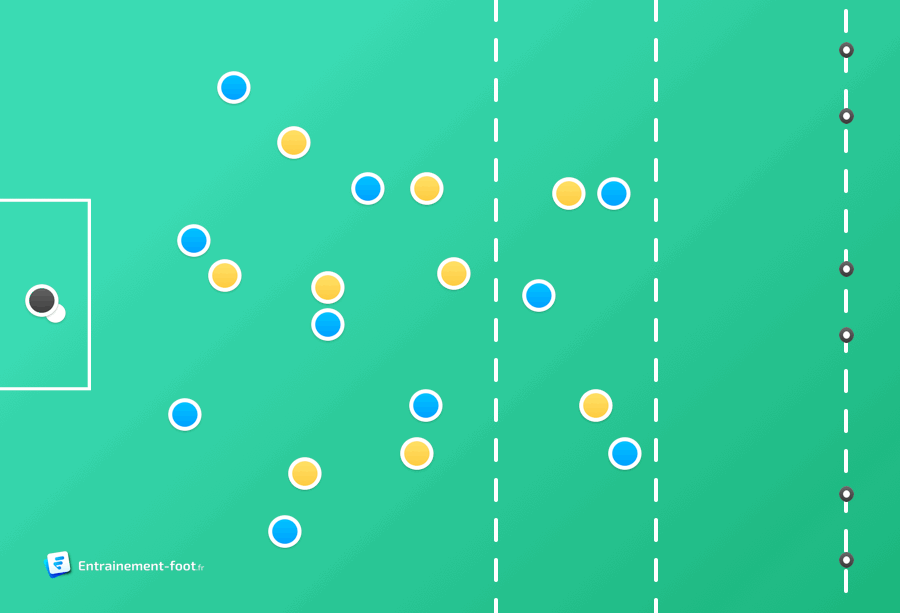Table of Contents
Nowadays, many teams use a 4-3-3 tactical formation, such as Jurgen Klopp’s Liverpool a few years ago. However, to put pressure on the opposition, there are multiple different strategies: some formations stay in their initial 4-3-3 composition in order to press, while other teams change their tactics. Discover our complete guide to 4-3-3.
This tactical analysis covers the different varieties of pressing in a 4-3-3 game. We will give you an overview of the different forms, including their advantages and disadvantages and their consequences on the dry cleaning itself. Some teams will stay in 4-3-3 when pressing, while others will evolve in another form, with a clear intention: to better press the ball carrier .
The 4-3-3 focusing on central areas
A common way to press in a 4-3-3 formation is the way Liverpool press under Jürgen Klopp. The heart of their tactical approach is “game posotion” , and they will then attempt to guide the opposing team into the central areas of the pitch in order to regain possession of the ball via their three central players in midfield.

Liverpool’s pressing in 4-3-3 formation
This is why wingers are supposed to defend high up the pitch. As this creates space on the wing , the full-backs must be ready to move up the touchline in order to press as well. Ideally, wingers use their coverage area to prevent any passes into wider spaces. The central striker also presses the central defender and thus leaves only one passing lane, towards, you guessed it, the 3 central midfielders .
The basis behind this philosophy used at Liverpool is to primarily prevent sideways passes . If done well, this will force opposing defensive players to extend their coverage horizontally and vertically, thus forcing them to play in the center of the field . It’s sort of the opposite of the offensive process of moving the ball horizontally.
Exercise to work on the 4-3-3
Exercise inspired by a Jurgen Klopp training session at Liverpool, it will allow your players to work on their positioning in a 4-3-3 formation, while allowing the opposing team to practice high pressing.

Construction and deep play in 4-3-3 of Jurgen Klopp
On three quarters of the ground, demarcate a first low zone 35m wide, a central zone 7m and finally a finishing zone 15m wide. Then place 3 small goals on the goal line of the last zone. Finally, form 2 teams of 9 and 11 players including a goalkeeper.
The team which attacks on the small goals will position itself in 4-3-3 (11 players) and the team which defends in 2-4-3 (9 players) with a position high on the pitch.
The exercise will proceed as follows:
- The game starts from the goalkeeper (or the coach) and the team of 11 players (here the blues) will have to build to look for an attacker deep in the finishing zone.
- The 3 attackers located in the central zone cannot go down one step in the low zone. Only 1 attacker at a time can do this and come and offer a solution.
- The defending team (9 players) will press high and regain possession to finish on the big goal as quickly as possible.
- If the offensive team scores in the small goal, they score 1 point. If the opposing team gets the ball and scores in the big goal, they score 1 point (and 2 points if they score in less than 10 seconds).
The transition from 4-3-3 to 4-1-3-2
Another popular concept for using a 4-3-3 structure is to switch to a 4-1-3-2 when pressing . This is often used when the 4-3-3 is played with a deep midfielder, who plays behind two more advanced midfielders.
The advanced midfielders support the attacking players when pressing, while the deeper midfielder covers in front of the defense line.
Once the striker is on the far side of the ball, an advanced midfielder comes out to press.
The “attacking” midfielder was able to move forward while the wingers moved inside to form a new line of three.
This creates two zones within the team. A 4-1 to cover the spaces behind the defensive line, and a 3-2 to press the opposing team. The attacking 3-2 formation is particularly useful for putting pressure on opposing defenders, while controlling the center of the pitch and pushing defenders towards the touchline.
Should we press or let the opposing team come?
In summary, the different ways of adapting a 4-3-3 during pressing all have advantages and disadvantages. Some forms are rather useful for a defense approach that could be described as active, while others are suitable for a more wait-and-see way of defending.
In general, the ideal setup depends on the abilities of your team and players, as well as the strengths and weaknesses of the opponent.
Overall, when playing 4-3-3 there are many different pressing configurations. However, as our analysis shows, all tactics have certain advantages as well as disadvantages. Therefore, the strengths and weaknesses of your squad should be your best guide when choosing which tactics to apply .
Also remember to recall these choices and these tactical aspects during your pre-match chat , this will allow your players to be in the best conditions.
Happy coaching! 🙂
